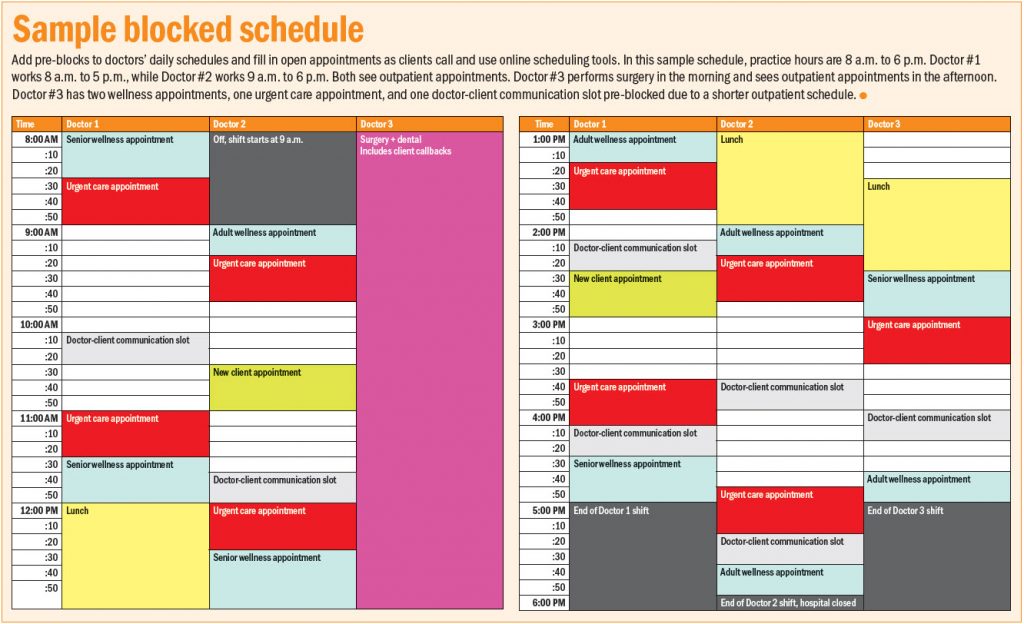
The everyday task of scheduling determines whether your practice has an efficient or chaotic workflow. Block scheduling reserves specific appointment types and activities in doctors’ daily calendars. This streamlines your scheduling process and creates structure that maximizes your team’s productivity and practice profits.
Set up appointment types in your scheduler. Each appointment type will have a reason for visit, length, and color code. As CSRs book exams throughout the day, create a rainbow of appointment types rather than large blocks of similar colors. For example, avoid three back-to-back sick patient appointments. You risk falling behind, causing a domino of late appointments. Instead, sandwich a sick patient exam between two checkups. Checkups are guardrails that contain the sick patient exam.
Use block scheduling for four appointment types in doctors’ daily schedules:
1) Wellness appointments
Use wellness appointment blocks to keep the schedule running on time. Wellness appointments are like slices of bread in a club sandwich, creating structured layers that hold the schedule together. If you take the bottom slice of bread off, put it on top, and pick up the sandwich, it will fall apart. Likewise, checkups are structured layers that keep your schedule on time and ensure the medical team gets meal breaks and goes home on time. Pre-block four wellness appointments in each doctor’s daily schedule to ensure efficient exam workflow:
- First appointment of the day. Doctors are confident about preventive care, which creates a positive mindset for the day.
- Appointment before lunch. As checkups are predictable and more likely to finish on time, the outpatient team can enjoy well-timed lunch breaks.
- Appointment after lunch. A wellness appointment after lunch begins the afternoon on time—like hitting a reset button.
- Last appointment of the day. Wrapping up the day with a checkup ensures the outpatient team goes home on time.
2) Urgent care appointments
Urgent care blocks improve availability of same-day care, which are high-value appointments. Clients will call every morning with sick patients needing same-day care. Be a hero and pre-block four to six urgent care exams in each doctor’s daily schedule:
- Second appointment of the day. Strive to sandwich a checkup after this urgent care slot.
- Two appointments before lunch. A checkup follows this urgent care exam to ensure the outpatient team goes to lunch on time.
- Two appointments after lunch. This urgent care follows a checkup. Sandwich it between another checkup at 2 p.m.
- Three appointments before end of shift/closing. Your last urgent care slot of the day should be 60 to 90 minutes before closing. This allows for appropriate workup and treatment time and ensures your team goes home on time.
Reserve more urgent care slots on Mondays, Fridays, and Saturdays, when most practices have higher sick-patient demands. If your practice is closed on Sundays, you will have more urgent care requests on Mondays. Fridays see a spike in clients whose pets became ill mid-week and took a wait-and-see approach. Conditions worsened, and now they need urgent care. Saturdays have increased demands for clients who work weekdays and prefer weekend appointments.
Stagger urgent care blocks by one hour in multi-doctor practices. This eliminates bottlenecks in the treatment area, laboratory, and radiography when several patients need workups. You will also prevent the steal-the-technician game among doctors. Block urgent care appointments about every 90 minutes. Here’s an example of urgent care blocks when two doctors are seeing outpatient appointments:
| Doctor 1: Urgent care slots | Doctor 2: Urgent care slots |
| 9:00 a.m. | 10:00 a.m. |
| 10:30 a.m. | 11:30 a.m. |
| 12:00 p.m. | 1:00 p.m. |
| 1:30 p.m. | 2:30 p.m. |
| 3:00 p.m. | 4:00 p.m. |
| 4:30 p.m. | 5:30 p.m. |
Reserve the last urgent care slot 60 to 90 minutes before closing. If your practice closes at 6 p.m., your last urgent care slot will be 4:30 p.m. Never have your last appointment of the day as an urgent care slot. You and your team risk working late, and you are paying overtime.
If you are a practice owner or manager who is anxious about having six empty appointments held in your daily schedule, do not worry. Urgent care slots always get taken. If you are skeptical, release open urgent care slots 90 minutes before the reserved block.
Let’s say you have an urgent care block at 11 a.m. It is now 9:30 a.m. and, miraculously, no one has called with a sick pet needing to be seen today. Your next call is a client who adopted a kitten over the weekend and needs an appointment. Say, “Congratulations on your new baby! We’d love to meet your kitten today. Dr. has an appointment available at 11 a.m. Can we see then?”
| Check out the author’s online course on Scheduling Mastery to learn block scheduling, ways to prevent no-shows, share guidelines for doctor and technician appointments, and best practices for online scheduling tools. |
3) New client appointments
Patients will pass away, and clients will move or leave your practice. To maintain a growing practice, you need to welcome new clients. Pre-block new client appointments based on your monthly average number of new clients. If a full-time doctor averages 25 new clients per month, pre-block one new client appointment daily. Use mid-morning or mid-afternoon slots, often the last appointments to be filled.
4) Doctor-client communication slots
Get administrative tasks done with doctor-client communication blocks. Veterinarians need administrative time to review lab results, update medical records, approve prescriptions, and call/text/email clients and vendors. Without dedicated time for administrative duties, veterinarians risk job burnout and mental health.
Reserve three 20-minute slots at mid-morning, mid-afternoon, and near the end of the day, such as 10:10 a.m., 2:10 p.m., and 4:10 p.m. If a client calls at 11 a.m. about her cat’s lab results and asks to speak with the veterinarian, the CSR can explain, “Dr. is seeing appointments now and will be available between 2:10 and 2:30 p.m. to return calls. What is the best phone number to reach you, and may the doctor also text you?” You will set expectations and may be able to turn a callback into a faster “text back” for appropriate types of communication.
Set up a “template week” to make it easier to copy and paste a block schedule (See: Sample blocked schedule). Block scheduling lets your practice schedule efficiently and balance the mix of wellness and sick patient appointments. Clients will be grateful for same-day availability of urgent care appointments, and you will appreciate how these high-value appointments boost your revenue.
Wendy S. Myers, CVJ, knows the right words will lead clients to say yes to your medical recommendations. As founder of Communication Solutions for Veterinarians, she is an online course creator, keynote speaker, and respected communication expert. Myers was a partner in an AAHA-accredited specialty and emergency hospital. Learn how she can train your team at csvetscourses.com.

